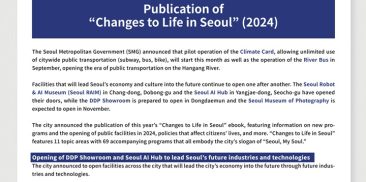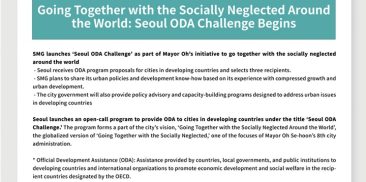2022 Seoul Survey results: statistics on citizens, foreigners, and parents
– 2022 Seoul Survey to analyze the daily lives of citizens, foreigners, and parents in Seoul
– Utilization of survey results as fundamental data for policies
– Rise in citizens’ cultural and outdoor activities in 2022 as part of the citywide return to normalcy
– Seoul, “a trendy city that strives to achieve cultural value” to foreigners; over half recommends living in Seoul (57.1%)
– Decrease in discrimination experienced by foreigners by 15%p (53.1% in 2020 → 38.1% in 2022), showing higher happiness index value than Seoul citizens
– Seoul parents showed low satisfaction in leisure life than unmarried couples or those with no children, but had higher happiness index values and lower levels of loneliness
The Seoul Metropolitan Government (SMG) announced the results of the 2022 Seoul Survey by analyzing the average daily lives of citizens, foreigners, and parents of preschool children in Seoul. The city will use the survey results to develop various policies and research projects dedicated to make Seoul an attractive city of solidarity.
Daily Lives of Seoul Citizens (2022)
Citywide return to normalcy (pre-pandemic recovery)
In 2022, Seoul citizens were gradually returning to pre-pandemic life. There was a significant rise in the number of face-to-face cultural activities (theater performances, movies, exhibitions, expos, etc.) and social activities (social gatherings, clubs, school reunions, etc.). The level of leisure activities increased dramatically both on weekdays and weekends while there was a stark decrease in online activities.
[Change in the rate of participation in cultural and social activities]
Participation in Cultural Activities
| Category |
Cultural activities (%) |
Face-to-face cultural activities (%) |
Online cultural activities (%) |
| 2021 |
55.7 |
40.1 |
40.3 |
| 2022 |
63.8 |
54.3 |
34.5 |
Participation in Social Activities and Activity Type
| Year |
Participation rate in social activities (%) |
Social gatherings (%) |
School reunions (%) |
Online community (%) |
| 2021 |
57.7 |
29.6 |
24.5 |
16.1 |
| 2022 |
60.9 |
31.4 |
30.4 |
6.2 |
In addition, big data (credit card and active population) collected by the city indicated that life in Seoul was returning back to pre-pandemic levels (2020).
Changes in credit card sales and de facto population (2019–2022)
| Number and amount of credit card transactions (daily average) |
Active population (daily average) |
| Unit: KRW 100 million |
Unit: million people |
| Transactions |
Amount |
Weekdays |
Average |
Weekends |
| ※ The average number and amount of credit card transactions made in Seoul |
|
Daily Lives of Foreigners in Seoul
“I’m a Seoul citizen, and I want to keep living in Seoul.”
In 2022, survey results showed that foreigners living in Seoul expressed that they “live in Seoul” rather than “live in Korea.” In addition, the rate of discrimination that Seoul-residing foreigners experienced was 38.1%, which is a drastic 15%p decrease from 53.1% in 2020.
Sense of belonging felt by foreigners in Seoul
| Category (Unit: Point) |
Total |
Nationality |
| China |
Asia |
Anglosphere |
| Seoul |
4.98 |
5.75 |
4.87 |
4.03 |
| Korea |
4.63 |
5.10 |
4.57 |
4.10 |
The respondents reported their difficulties of living in Seoul were childrearing and education, acquiring opportunities to engage in economic activities and housing. Different age groups experienced different difficulties of living in Seoul, however they were similar to the difficulties experienced by different age groups of Seoul citizens.
Difficulties of living in Seoul reported by expatriates (by age group)
| No. |
Total |
20s and 30s |
40s and 50s |
60s and older |
| 1 |
Childrearing and education (4.99 pts) |
Acquisition and change of residence qualifications, such as visas (4.93 pts) |
Childrearing and education (5.33 pts) |
Opportunities of economic activity (4.81 pts) |
| 2 |
Opportunities of economic activity (4.83 pts) |
Opportunities of economic activity (4.91 pts) |
Use of medical facilities (4.85 pts) |
Residence, such as housing (4.53 pts) |
| 3 |
Residence, such as housing (4.71 pts) |
Forming amicable relationships with Koreans (4.85 pts) |
Residence, such as housing (4.79 pts) |
Resolution of civil complaints through public agencies (4.28 pts) |
Difficulties faced by foreigners in Seoul
□ Despite the difficulties foreigners faced while living in an unfamiliar city of Seoul, the foreigners living in the area were happier than its citizens. Over half of the foreign residents living in Seoul wished to continue to reside in the city (56.3%) and recommended the life in Seoul (57.1%).
○ Happiness index: Seoul-residing foreigners (7.07 points), Seoul citizens (6.72 points)
Daily Lives of Parents in Seoul
Childrearing and fostering by parents in Seoul
□ The burden of mothers was still high in terms of childrearing in Seoul. The survey result showed that the primary cause of stress was different between Seoul mothers and fathers with preschool children. In both single-income and two-income families, the primary cause of stress for fathers was work related (social interactions and excessive workload) while the biggest cause of stress for mothers was family responsibilities and housework. Mothers from single-income households showed a much higher level of stress from family responsibilities and housework.
Housework sharing and primary cause of stress in families with preschool children
| Division of housework in families with preschool children |
Primary causes of stress (No.1 and No.2) |
| Unit: % |
Unit: % |
| Two-income household |
The wife takes the sole responsibility. |
Double income household |
Males |
Health state |
| Single-income household |
The wife is mostly responsible, and the husband helps a little |
Single-income household |
Females |
Financial state,The relationship with family and friends |
| The wife and husband divide housework fairly |
Work-related social interaction, Excessive workload and study load |
| The husband is mostly responsible, and the wife helps a little |
Unemployment |
| The husband takes the sole responsibility. |
Family responsibilities and housework |
Regardless of the employment status and income level of mothers and fathers, the predominant method of taking care of preschool children was daycare centers and kindergartens. Following daycare centers and kindergartens, the most common method of childcare was grandparents and relatives.
The daily life of Seoul mothers and fathers with preschool children revolved around their children. Seoul mothers and fathers had the lowest level of satisfaction with their leisure life in comparison to singles and couples without children. However, they showed the highest level of Happiness Index (health state, financial state, relationship with friends, family, and social life) and the lowest level of loneliness. It can be interpreted that Seoul mothers and fathers enjoy greater happiness from having a child despite the stress associated with childrearing and limited cultural engagement.
Download survey data
○ Visit data.seoul.go.kr
– Report: ▸ Statistics ▸ Publications ▸ “도시정책지표조사” (Seoul Survey) ▸ 2023 ▸ “2022 도시정책지표조사 보고서” (2022 Seoul Survey Report)
– Microdata: ▸ Search “도시정책지표조사” (Seoul Survey)











